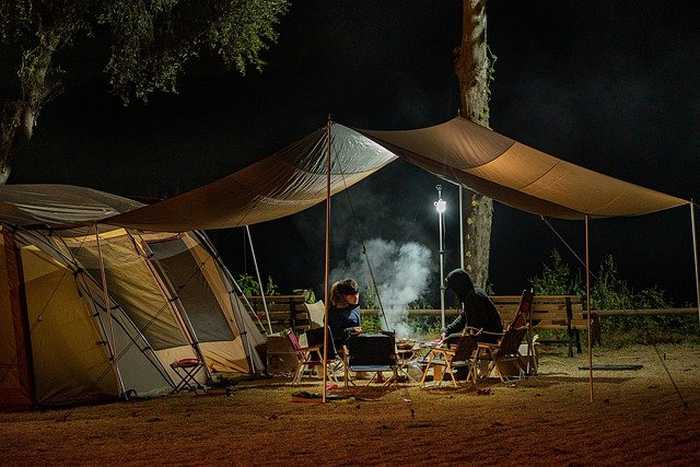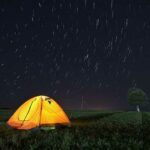You might be wondering whether it’s safe to keep your backpack in your tent overnight. After all, you don’t want any hungry animals to sniff out your food and make off with your provisions!
Generally speaking, as long as you haven’t spilled any food or other smelly substances on your backpack, and as long as all tempting snacks are safely stored in a bear bag (i.e. suspended from a tree), you should be fine keeping your pack on the ground overnight. This goes for propping it up against a tree, placing it in your tent’s vestibule, or even just leaving it out in the open.
Of course, if you’re camping in an area with known predators (like bears), you’ll want to take extra precautions to protect yourself and your belongings. In these cases, it’s best to err on the side of caution and keep your pack inside your tent with you.
What should you not keep in a tent?
You should not keep any supplies in your tent that have a strong smell, such as toothpaste and deodorant. Bears are attracted to anything with a strong smell, so it’s best to keep these items outside of your tent.
You also shouldn’t sleep in clothes that you’ve worn while cooking or eating, as the food smells can attract bears as well. Hang these clothes in plastic bags away from your tent, along with any other smelly items.
What else will you be putting in your backpack in hiking and camping?
There are a few things you’ll want to make sure you have in your backpack when hiking and camping. In addition to an insulated jacket, fleece jacket and pants, and rain jacket, you’ll also want to pack a first-aid kit. If you’re planning on drinking any water from streams or lakes, be sure to bring along a water filter or purifier.
What do you put on the floor of your tent?
There are a few different options you can choose from when it comes to what you put on the floor of your tent. Interlocking foam tiles are a great option for promoting comfort and convenience. They’re easy to install and can be customized to fit any space. Plus, they’re also waterproof and easy to clean.
If you’re looking for something a little warmer, fluffy blankets are always a good choice. They’ll keep you cozy all night long and can be easily packed up in the morning. Just make sure to shake them out before folding them up so they don’t get too wrinkled.
Tent floor carpets are another popular option, especially if you’re planning on spending a lot of time in your tent. They add an extra layer of insulation and can help reduce noise levels inside the tent. Plus, they come in a variety of colors and designs so you can find one that fits your style perfectly.
Finally, there are also several different types of mats and rugs designed specifically for use in tents. These usually have some sort of waterproof backing or coating to protect against moisture damage.
How do you make a tent pad?
A tent pad is a platform made of durable material that you place your tent on top of. It helps to keep your tent clean and dry, and also makes it more comfortable by providing a level surface to sleep on.
You can make a tent pad out of almost any type of materials, but some common choices include tarpaulin, plywood, or even cardboard. If you’re planning on using your tent pad in wet weather, be sure to choose a material that won’t absorb water and become soggy.
To build your own tent pad, start by finding a flat, level spot to put it. Then measure the size of your tents footprint and cut the material you’re using to that size.
Once you have your piece cut to size, add some grommets around the edges so you can secure it to the ground with stakes or guy lines.
What should I bring for backpack camping?
There are a few things you’ll need to bring for backpack camping. First, you’ll need a good pair of hiking boots or shoes. You’ll also need a backpack, tent, sleeping bag, and sleeping pad.
Don’t forget your stove and fuel, as well as kitchen supplies. And of course, you’ll need plenty of food and water. Be sure to pack water bottles and water-treatment supplies too.
How do you pack a backpack for camping?
To pack a backpack for camping, start by filling your hydration reservoir and placing it in your pack. Then, stuff your sleeping bag in the bottom of your bag.
Fill out extra space with a small sleeping pad, camp clothes and/or a camp pillow. Finally, layer your heaviest gear against the back of the pack, including camp food, your cook system and tent body.
What do you do with your backpack when camping?
When you’re packing for a camping trip, there are a few things to keep in mind when it comes to your backpack.
First, you’ll want to make sure you have a good hydration reservoir. Fill it up and place it in your pack so you can stay hydrated on the trail.
Next, stuff your sleeping bag into the bottom of your pack. This will help keep you warm at night and give you a place to rest after a long day of hiking.
Finally, fill out any extra space with a small sleeping pad, camp clothes, and a camp pillow. This will help make your campsite more comfortable and give you somewhere to store your gear while you’re not using it.
How do you pack a backpack for 3 days?
When you’re packing your backpack for camping or hiking, it’s a good idea to follow the three-part rule: bottom, middle, and top. That way, you can make sure the heaviest items are in the center of the pack and easily accessible essentials are on top.

How do you pack a backpack for winter camping?
When packing your backpack for winter camping, it’s important to keep a few things in mind.
First, fill your hydration reservoir and place it in your pack. This will help you stay hydrated during your hike.
Second, stuff your sleeping bag in the bottom of your pack. This will keep it from getting too cold at night.
Third, fill out extra space with a small sleeping pad, camp clothes and/or a camp pillow. These items will help you stay warm and comfortable during your trip.
Finally, layer your heaviest gear against the back of the pack, including camp food, your cook system and tent body.
What do you do with your backpack while camping?
If you’re like most people, you probably don’t give much thought to what you do with your backpack when camping. After all, it’s just a bag, right? Wrong! What you do with your backpack can actually have a big impact on your camping experience.
Here are a few things to keep in mind when deciding what to do with your backpack while camping:
1. If possible, avoid putting your backpack on the ground. This will help keep it clean and dry.
2. If you must put your backpack on the ground, use a piece of tarp or other waterproof material to protect it from the elements.
3. When setting up camp, take advantage of any available storage space. This could mean hanging your backpack from a tree branch or stashing it under a bush.
4. Keep an eye on your belongings at all times. This is especially important if you’re camping in an area where wildlife is present.
Do you keep your backpack in your tent?
As long as your backpack doesn’t have any food or smelly substances in it, you should be fine keeping it in your tent overnight.
This includes propping it against a tree, placing it in your tent’s vestibule, or even just leaving it on the ground inside your tent. Just make sure all temptations (food, etc.
What can I put on my tent floor?
There are a few different things you can put on your tent floor to make it more comfortable. One option is interlocking foam tiles. These tiles fit together snugly, creating a soft and cushioned surface that’s ideal for camping.
Another option is a fluffy blanket. This will add some extra warmth and cushioning to your tent floor. Finally, you could also consider using a tent floor carpet or mat. These can provide additional insulation and comfort, making your tent feel like home.
How do you keep a tent floor dry?
There are a few things you can do to keep your tent floor dry. First, always set your tent up on higher ground than the surrounding area. This will help ensure that water doesn’t pool around your tent.
Second, place a ground cloth or tarp underneath your tent. This will help protect the bottom of your tent from moisture and mud.
Finally, make sure you have a good rain fly on your tent. A well-designed rain fly will provide excellent coverage and help keep the inside of your tent dry during wet weather.







